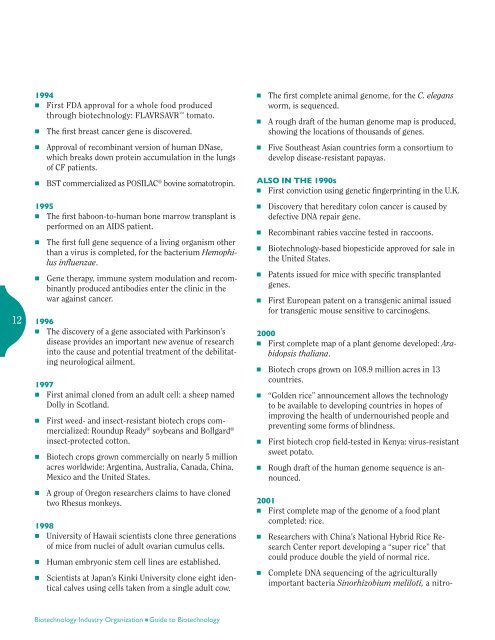Introduction Guide to Biotechnology - Biomolecular Engineering Lab
Introduction Guide to Biotechnology - Biomolecular Engineering Lab
Introduction Guide to Biotechnology - Biomolecular Engineering Lab
Create successful ePaper yourself
Turn your PDF publications into a flip-book with our unique Google optimized e-Paper software.
12<br />
1994<br />
n First FDA approval for a whole food produced<br />
through biotechnology: FLAVRSAVR <strong>to</strong>ma<strong>to</strong>.<br />
n The first breast cancer gene is discovered.<br />
n Approval of recombinant version of human DNase,<br />
which breaks down protein accumulation in the lungs<br />
of CF patients.<br />
n BST commercialized as POSILAC ® bovine soma<strong>to</strong>tropin.<br />
1995<br />
n The first baboon-<strong>to</strong>-human bone marrow transplant is<br />
performed on an AIDS patient.<br />
n The first full gene sequence of a living organism other<br />
than a virus is completed, for the bacterium Hemophilus<br />
influenzae.<br />
n Gene therapy, immune system modulation and recombinantly<br />
produced antibodies enter the clinic in the<br />
war against cancer.<br />
1996<br />
n The discovery of a gene associated with Parkinson’s<br />
disease provides an important new avenue of research<br />
in<strong>to</strong> the cause and potential treatment of the debilitating<br />
neurological ailment.<br />
1997<br />
n First animal cloned from an adult cell: a sheep named<br />
Dolly in Scotland.<br />
n First weed- and insect-resistant biotech crops commercialized:<br />
Roundup Ready ® soybeans and Bollgard ®<br />
insect-protected cot<strong>to</strong>n.<br />
n Biotech crops grown commercially on nearly 5 million<br />
acres worldwide: Argentina, Australia, Canada, China,<br />
Mexico and the United States.<br />
n A group of Oregon researchers claims <strong>to</strong> have cloned<br />
two Rhesus monkeys.<br />
1998<br />
n University of Hawaii scientists clone three generations<br />
of mice from nuclei of adult ovarian cumulus cells.<br />
n Human embryonic stem cell lines are established.<br />
n Scientists at Japan’s Kinki University clone eight identical<br />
calves using cells taken from a single adult cow.<br />
n The first complete animal genome, for the C. elegans<br />
worm, is sequenced.<br />
n A rough draft of the human genome map is produced,<br />
showing the locations of thousands of genes.<br />
n Five Southeast Asian countries form a consortium <strong>to</strong><br />
develop disease-resistant papayas.<br />
Also in the 1990s<br />
n First conviction using genetic fingerprinting in the U.K.<br />
n Discovery that hereditary colon cancer is caused by<br />
defective DNA repair gene.<br />
n Recombinant rabies vaccine tested in raccoons.<br />
n <strong>Biotechnology</strong>-based biopesticide approved for sale in<br />
the United States.<br />
n Patents issued for mice with specific transplanted<br />
genes.<br />
n First European patent on a transgenic animal issued<br />
for transgenic mouse sensitive <strong>to</strong> carcinogens.<br />
2000<br />
n First complete map of a plant genome developed: Arabidopsis<br />
thaliana.<br />
n Biotech crops grown on 108.9 million acres in 13<br />
countries.<br />
n “Golden rice” announcement allows the technology<br />
<strong>to</strong> be available <strong>to</strong> developing countries in hopes of<br />
improving the health of undernourished people and<br />
preventing some forms of blindness.<br />
n First biotech crop field-tested in Kenya: virus-resistant<br />
sweet pota<strong>to</strong>.<br />
n Rough draft of the human genome sequence is announced.<br />
2001<br />
n First complete map of the genome of a food plant<br />
completed: rice.<br />
n Researchers with China’s National Hybrid Rice Research<br />
Center report developing a “super rice” that<br />
could produce double the yield of normal rice.<br />
n Complete DNA sequencing of the agriculturally<br />
important bacteria Sinorhizobium meliloti, a nitro-<br />
<strong>Biotechnology</strong> Industry Organization n <strong>Guide</strong> <strong>to</strong> <strong>Biotechnology</strong>
















